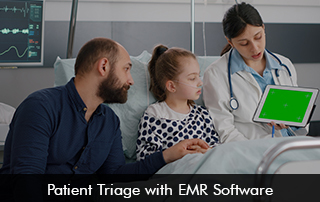Automating patient triage with Electronic Medical Records (EMR) Software is a great way to reduce the chances of physician burden and optimize ER visits. The main aim of patient triage is to ensure that patients who severely need medical attention receive it without any delays hence improving patient survival rates. Triage is used in emergency departments and disaster situations. For example during the COVID-19 pandemic Mayo Clinic automated and streamlined its patient triage system to efficiently make use of critical care resources.
How can EHR Software systems help with Patient Triage?
To improve and expedite the triage process, digital tools are integrated into Electronic Health Records software for patient triage. EMR systems have the potential to greatly increase triage’s effectiveness, precision, and coordination across a range of healthcare environments.
Automated Triage Algorithms
Triage algorithms, which automatically classify patients based on the input of symptoms, vital signs, and medical history, can be incorporated into the robust technology of EHR software. This aids in bringing uniformity to the triage procedure.
Real-time Data
The seamless access to real-time patient data in EMR Software is critical for healthcare providers to make accurate triage decisions. Through the data, clinicians can assess and categorize the severity of medical conditions.
Integration with Monitoring Devices
The amount of time needed for manual data entry can be decreased by using electronic medical records software to interface with medical monitoring equipment. This can automatically collect vital signs and other important data efficiently.
Care Collaboration
Electronic Health Records (EHR) Software has communication tools and interoperability options to facilitate care team coordination between different departments. Quick communication ensures that everyone involved in the patient care process knows the triage status and the treatment plan.
Patient Tracking and Queuing
EMR systems can monitor wait times, handle patient lines, and make sure patients are seen according to their triage category.
Benefits of Leveraging EHR Software for Patient Triage
- Automating patient triage with Electronic Medical Records Software can improve efficiency as the time required for assessment and categorization decreases.
- Decision Support tools in the software system can help eliminate any chances of human errors in triage decisions.
- When the triage process is streamlined providers can timely intervene and offer care to critical patients hence boosting health outcomes.
- Real-time data and tracking make it easier to manage workers and resources, particularly in high-volume or resource-constrained environments.
- EMR systems record all triage actions and can provide reports for regulatory compliance and internal evaluation.
Ending Note
Implementing an EHR Software system can make the patient triage process more effective and empower providers to offer safe and better care in emergencies. However, it is important to keep in mind that training staff members to use the EMR Software and the right use of triage features in the system can furthermore advance patient triage and enable staff members to maximize the benefits of Electronic Health Records Software.








